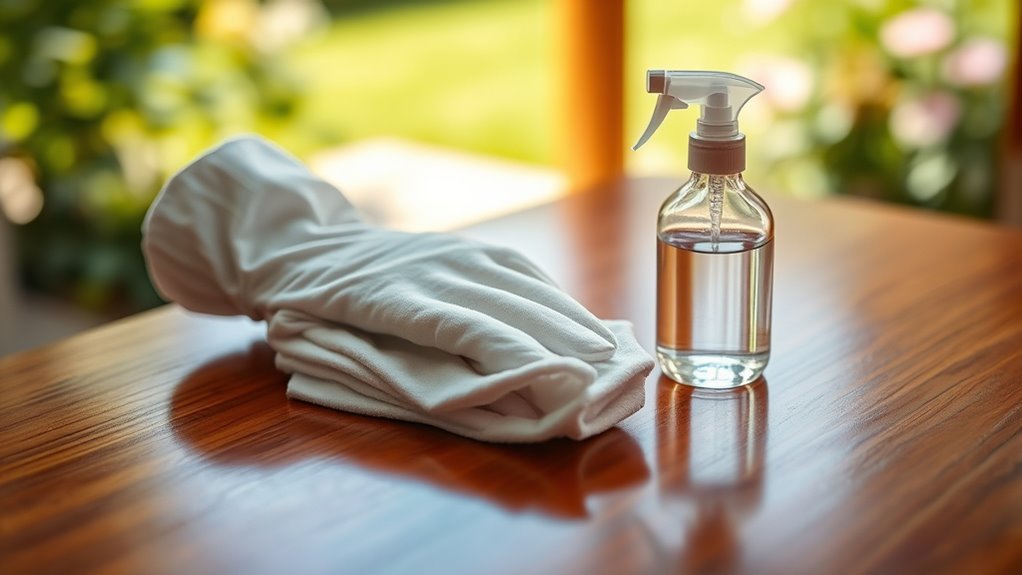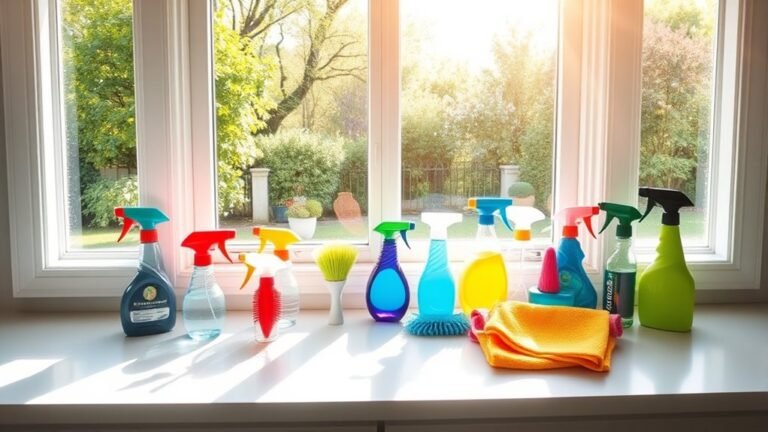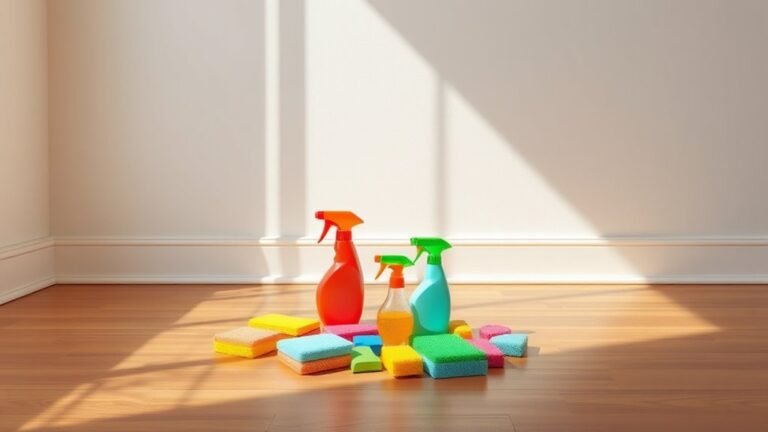How to Clean Wood
To clean wood effectively, first identify its finish since oil, wax, or varnish each need different care. Use a soft microfiber cloth and a mild wood cleaner or diluted pH-neutral soap. Dust gently to avoid scratches, and clean sealed wood with a damp cloth following the grain. Avoid excess moisture and harsh chemicals, then dry thoroughly. For raw or antique pieces, use extra care and gentle methods. Keep going to discover how to tackle stains and maintain wood’s beauty long term.
Understanding Different Types of Wood Finishes

When cleaning wood, why does it matter what type of finish you’re dealing with? Different wood finish types—such as varnish, lacquer, oil, wax, or polyurethane—respond uniquely to cleaning products and techniques. Using the wrong cleaner can damage the finish or strip it away, so you need to identify the finish first. For instance, oil finishes absorb moisture and require gentle cleaning with oil-based products, while polyurethane is more durable but sensitive to harsh chemicals. Avoid ammonia or bleach on delicate finishes like wax or shellac, as they can dull or crack the surface. By understanding your wood finish type, you can select the right cleaning products, preserving the wood’s natural beauty and extending its lifespan. This knowledge gives you the freedom to maintain your wood confidently and effectively.
Essential Tools and Cleaning Supplies for Wood
Before you start cleaning your wood surfaces, you’ll need the right tools and supplies to do the job effectively without causing damage. Proper wood care depends on using maintenance products designed specifically for wood, ensuring you preserve its natural beauty and durability. Here are the essentials you’ll want on hand:
Gather the right tools and wood-specific products to clean effectively without damaging your surfaces.
- Soft microfiber cloths – Gentle on wood, these cloths prevent scratches while removing dust and grime.
- Mild wood cleaner or pH-neutral soap – Choose maintenance products that won’t strip finishes or cause discoloration.
- Soft-bristle brush – Ideal for crevices and textured wood surfaces, helping you reach dirt without abrasion.
Having these tools ready empowers you to maintain your wood freely and confidently, keeping it looking great for years to come.
Preparing Wood Surfaces for Cleaning
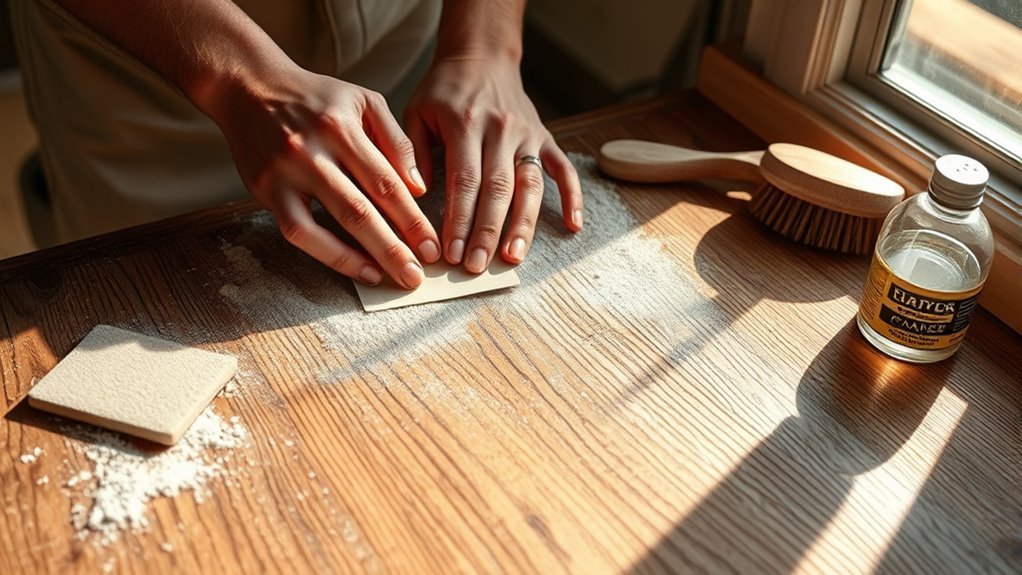
Before you start cleaning, make certain to remove any dust and debris from the wood surface using a soft brush or microfiber cloth. Choose the right cleaning tools that won’t scratch or damage the wood finish. Always test your cleaning solution on a small, hidden area to guarantee it won’t cause discoloration or harm.
Remove Dust and Debris
Although it might seem simple, removing dust and debris is an essential first step in preparing wood surfaces for cleaning. You want to guarantee that the surface is free from loose particles that could scratch or interfere with your cleaning efforts. Start by using effective dusting techniques to lift and capture dust without spreading it around. For thorough debris removal, follow these steps:
- Use a soft, dry microfiber cloth or a feather duster to gently sweep away dust from all wood surfaces.
- For corners and crevices, employ a soft-bristled brush to dislodge trapped debris.
- Finally, vacuum the area with a brush attachment to pick up any remaining particles.
This careful approach prevents damage and prepares your wood for a deeper clean.
Choose Appropriate Cleaning Tools
Once you’ve cleared away dust and debris, the next step is to gather the right tools for cleaning your wood surfaces. Start with soft wood brushes—these are gentle enough to avoid scratching but effective at loosening dirt in grooves and grain patterns. Avoid stiff bristles that can damage the finish. Next, choose cleaning solutions suited for wood, preferably mild and pH-neutral to preserve the wood’s natural oils and finish. Have clean, lint-free cloths or microfiber towels ready for wiping and drying. You might also want a bucket for diluting your cleaning solution and a spray bottle for even application. Selecting the proper tools gives you control and freedom to clean thoroughly without risking damage, setting the stage for the best possible results on your wood surfaces.
Test Cleaning Solutions First
How should you determine if a cleaning solution is safe for your wood surfaces? The key is to test solutions in a controlled way before fully applying them. Here’s how to do effective solution testing:
- Pick a hidden spot on the wood, like the back or underside, where damage won’t be obvious.
- Apply a small amount of the cleaning solution and wait 10-15 minutes to observe any discoloration, warping, or finish damage.
- If the wood looks unchanged and feels normal, you’ve confirmed the solution is safe to use on the entire surface.
Cleaning Unfinished and Raw Wood
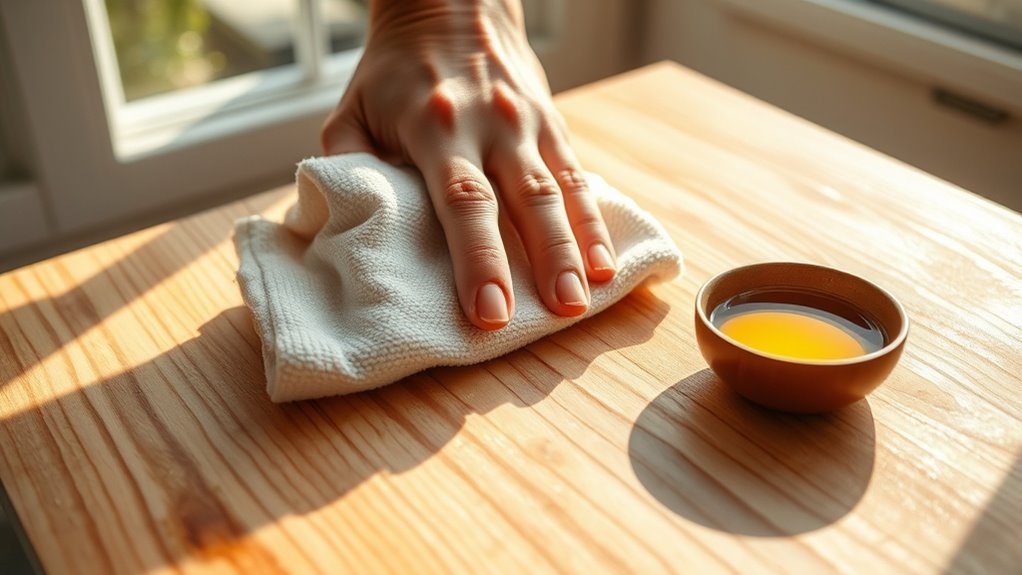
When cleaning unfinished or raw wood, you’ll want to use gentle methods like a soft brush or a damp cloth to avoid damaging the surface. For stubborn stains, try a mixture of mild soap and water, applying it carefully without soaking the wood. Always test your cleaning solution on a small, hidden area first to guarantee it won’t cause discoloration or harm.
Gentle Cleaning Methods
Since unfinished and raw wood is more porous and sensitive than sealed surfaces, you’ll need to use gentler cleaning methods to avoid damage. Start by choosing eco friendly cleaners designed for wood care; harsh chemicals can penetrate and weaken the fibers. Next, follow these steps:
- Lightly dampen a soft cloth or sponge with a mild solution of water and a few drops of your chosen cleaner.
- Gently wipe the wood’s surface, avoiding excess moisture that can cause swelling or warping.
- Immediately dry the wood with a clean, absorbent cloth to prevent water absorption.
Stain Removal Techniques
After gently cleaning unfinished wood, you might notice stubborn stains that won’t come off with basic wiping. Different stain types—like oil, ink, or water—require specific removal methods. For oil-based stains, sprinkle baking soda and gently scrub with a damp cloth; for ink, try applying a bit of rubbing alcohol on a cotton swab carefully. Water stains can often be lifted by rubbing with a fine steel wool pad dipped in lemon oil. Always test in a hidden area first to prevent damage. To maintain your freedom from future stains, practice stain prevention: immediately blot spills, avoid harsh chemicals, and regularly dust the surface. These steps help keep your unfinished wood looking natural and clean without sacrificing its raw beauty.
Techniques for Cleaning Sealed and Varnished Wood
Although sealed and varnished wood offers a protective layer against moisture and stains, you still need to clean it carefully to avoid damaging the finish. Proper wood care means using gentle methods and the right cleaning products to maintain its shine and durability. Here’s how you can do it:
Sealed and varnished wood needs gentle cleaning to protect its finish and keep it looking its best.
- Use a soft cloth dampened with a mixture of mild dish soap and water. Avoid soaking the wood—excess moisture can cause damage.
- Wipe the surface gently, following the grain to prevent scratches.
- Dry the wood thoroughly with a clean, dry cloth to prevent water spots or streaks.
Removing Stains and Spots From Wood
There are several effective methods you can use to remove stains and spots from wood without harming its surface. First, identify the stain types—water, oil, or ink require different treatments. For water stains, gently rub with a mixture of baking soda and water or use a damp cloth with a bit of toothpaste. Oil stains respond well to a mild dish soap solution applied with a soft cloth. Ink stains might need rubbing alcohol, but test in an inconspicuous spot first. Adjust your cleaning frequency based on how often the wood is used or exposed to spills. Regular, gentle cleaning prevents stains from setting, reducing the need for harsher methods. Remember, quick action and appropriate treatment preserve wood’s natural beauty while giving you the freedom to enjoy your space.
How to Clean Antique and Delicate Wood Pieces
When you’re cleaning antique or delicate wood pieces, you’ll want to take extra care to avoid damaging their finish or structure. These items require gentle handling and specific techniques for effective antique care and delicate restoration.
- Use a soft, lint-free cloth slightly dampened with a mixture of mild soap and water. Avoid soaking the wood to prevent warping.
- Test any cleaning solution on an inconspicuous area first to guarantee it won’t harm the finish or patina.
- For stubborn dirt, gently apply a wood-safe cleaner with a soft brush, then immediately wipe dry to protect the wood’s integrity.
Tips for Maintaining Wood After Cleaning
Once you’ve thoroughly cleaned your wood surfaces, maintaining their condition is key to preserving their beauty and durability. Start by establishing a consistent maintenance routine that suits your wood’s type and finish. Regularly dust with a soft, dry cloth to prevent buildup. Incorporate wood conditioning treatments every few months to replenish natural oils and protect against drying or cracking. Choose a conditioner appropriate for your wood species and apply it evenly, following product instructions. Avoid excess moisture and harsh chemicals during upkeep, as they can damage the wood. Keep your wood away from direct sunlight and extreme temperatures to prevent warping. By committing to these straightforward steps, you’ll guarantee your wood remains vibrant, resilient, and free to enhance your space for years to come.
Common Mistakes to Avoid When Cleaning Wood
Although cleaning wood might seem straightforward, you can easily damage the surface if you don’t avoid certain common mistakes. To keep your wood looking its best, consider these key points:
- Overdoing cleaning frequency: Too much cleaning can strip natural oils. Stick to a routine that suits the wood type and environment, avoiding daily harsh scrubbing.
- Using the wrong furniture polish: Not all polishes are created equal. Avoid silicone-based or wax-heavy products that build up and dull the finish over time. Opt for a polish formulated for your specific wood.
- Ignoring water damage risks: Excess moisture can warp or stain wood. Always use a damp, not wet, cloth and dry immediately to prevent damage.
Häufig gestellte Fragen
Can I Use Vinegar to Clean Wood Surfaces?
You can use vinegar to clean wood surfaces, but you’ll want to be cautious. Vinegar benefits include its natural disinfectant properties, but because it’s acidic, it might damage the finish or affect wood preservation if used undiluted. You should mix equal parts water and vinegar, apply gently with a soft cloth, and avoid soaking the wood. This way, you’ll clean effectively without risking harm to your wood’s integrity.
How Often Should I Clean Wooden Furniture?
You might think cleaning wooden furniture too often could damage it, but proper wood maintenance actually protects your investment. Aim for a regular cleaning frequency of once a week with a soft cloth to remove dust and prevent buildup. For deeper cleaning, do it every few months using gentle wood-safe products. This routine keeps your furniture looking great and extends its life, giving you more freedom to enjoy your space without worry.
Is It Safe to Use Steam Cleaners on Wood?
When considering steam cleaner safety for wood, you should be cautious. Steam can penetrate and damage wood finishes or cause warping if not used properly. To protect your furniture, keep the steam cleaner on a low setting and avoid prolonged exposure. Always test on a hidden area first. For wood maintenance tips, regular dusting and using a damp cloth with mild cleaner are safer ways to keep your wood looking fresh without risking damage.
Can Wood Cleaning Products Harm Pets?
You want your home to be a safe haven, right? When using wood cleaning products, it’s wise to choose pet safe products to keep your furry friends out of harm’s way. Some cleaners contain harsh chemicals that may irritate or upset pets. For effective wood surface care without worry, pick gentle, non-toxic options labeled pet safe. Always follow instructions and keep pets away until surfaces are fully dry, ensuring freedom and safety for all.
How to Remove Odors From Wooden Items?
To remove odors from wooden items, sprinkle baking soda generously over the surface and let it sit for several hours or overnight—it absorbs unwanted smells effectively. Afterward, vacuum or gently wipe away the baking soda. For a fresh scent, mix a few drops of essential oils like lavender or eucalyptus with water in a spray bottle, then lightly mist the wood. This combo frees your wood from odors while keeping it natural and fresh.
